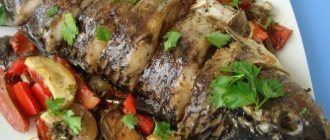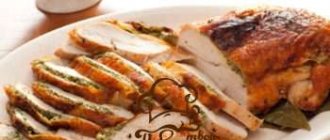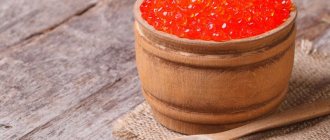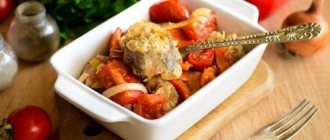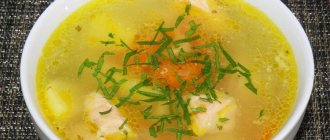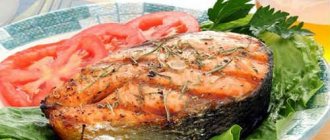The benefits and harms of salted salmon
Fish are often raised in special farms where antibiotics and growth hormones are added to the feed. The drugs are necessary for the prevention of diseases and epidemics, since in one pool the density of individuals can be critical.
Growth hormones are added to feed to obtain greater profits, as product turnover increases every year.
Salmon grown in natural conditions differs from farmed salmon in lower fat content, but if cooked incorrectly, there is a risk of infection by parasites living in the body of the fish.
Regardless of living conditions, salmon always remains a very useful fish:
- It contains proteins that are easier to digest by the human body without overloading the liver and pancreas.
- Salmon contains many essential amino acids.
- Salmon meat has an antioxidant effect, as the vitamins it contains slow down aging and reduce the risk of developing cancer.
- Thanks to vitamin A, salmon meat supports vision.
- Salmon fish helps the body remove cholesterol, strengthening the heart and blood vessels.
- Regular consumption of salmon helps reduce inflammation and eliminate chronic diseases.
- Fish meat accelerates blood flow, preventing the formation of blood clots.
- Salmon has a rejuvenating and antiseptic effect, reducing the possibility of skin rashes, diathesis and psoriasis.
- Salmon helps strengthen the nervous system. It is recommended to include it in the mandatory diet for people suffering from neuroses, depression and chronic stress.
- Atlantic salmon helps tissue repair during injury or physical stress.
- Salmon can eliminate exacerbations of asthma and reduce the number of attacks.
- The calcium and phosphorus contained in the composition helps strengthen bone tissue, preventing the leaching of substances necessary for the musculoskeletal system.
- Atlantic salmon meat accelerates metabolic processes, stimulates the immune system and increases the body's protective functions.
- Salmon is often used to prevent vitamin deficiencies.
- This fish activates the brain.
- Eating salmon has a positive effect on the reproductive system of women and men. Fish is included in the mandatory diet when treating infertility.
Despite the large number of beneficial properties, Atlantic salmon can be harmful to health:
- Salmon is not recommended for people who are overweight, as it is quite high in calories.
- It is strictly forbidden to eat fish if you have a food allergy to seafood.
- It is not recommended to eat salted salmon if you have hypertension or kidney pathologies.
- Atlantic salmon can worsen the condition if a person has:
- disruptions to the endocrine system;
- tuberculosis;
- stomach ulcers;
- liver pathologies;
- gallbladder problems;
- stones in the bladder or kidneys.
- Due to its high fat content, Atlantic salmon causes diarrhea and bloating.
Composition and calorie content of salted fish
Salting salmon is the only cooking method that helps preserve the maximum amount of beneficial microelements. It is worth giving preference to fish cooked at home.
Atlantic salmon contains:
| Category | Substance | Amount per 100 g of salmon | Daily requirement | Percentage of daily value, % |
| Vitamins | A | 31 mcg | 900 mcg | 3,4 |
| E | 2.6 mg | 15 mg | 17,3 | |
| B1 | 0.2 mg | 2 mg | 10 | |
| B2 | 0.2 mg | 1.8 mg | 11,1 | |
| AT 3 | 6.2 mg | 15 mg | 41,3 | |
| AT 5 | 1.5 mg | 5 mg | 30 | |
| AT 6 | 0.9 mg | 1.9 mg | 47,4 | |
| AT 9 | 25 mcg | 405 mcg | 6,2 | |
| AT 12 | 4 mcg | 4 mcg | 100 | |
| RR | 12 mg | 20 mg | 60 | |
| Micro elements | Iodine | 52 mcg | 150 mcg | 34,7 |
| Cobalt | 0.2 mcg | 9 mcg | 2,2 | |
| Iron | 2.3 mg | 20 mg | 11,5 | |
| Copper | 255 mcg | 1000 mcg | 25,5 | |
| Nickel | 6 mcg | 250 mcg | 2,4 | |
| Manganese | 0.1 mg | 2 mg | 5 | |
| Zinc | 0.8 mg | 15 mg | 5,3 | |
| Selenium | 37 mcg | 60 mcg | 61,7 | |
| Fluorine | 450 mcg | 4000 mcg | 11,25 | |
| Molybdenum | 5 mcg | 75 mcg | 6,7 | |
| Macro elements | Chromium | 60 mcg | 49 mcg | 122,4 |
| Sulfur | 230 mg | 1000 mg | 23 | |
| Potassium | 220 mg | 2500 mg | 8,8 | |
| Phosphorus | 250 mg | 1000 mg | 25 | |
| Sodium | 800 mg | 1000 mg | 80 | |
| Calcium | 45 mg | 1000 mg | 4,5 | |
| Chlorine | 200 mg | 1200 mg | 16,7 | |
| Magnesium | 70 mg | 400 mg | 17,5 | |
| Sterols | Cholesterol | 108 mg | 200 mg | 54 |
| Acids | Saturated | 2.5 g | 15 g | 16,7 |
| Monounsaturated | 4.2 g | 30 g | 14 | |
| Polyunsaturated | 5.11 g | 20 g | 25,6 | |
| Omega-3 | 4.14 g | 3.5 g | 118,3 | |
| Omega-6 | 0.9 g | 15 g | 6 |
100 g of salted salmon contains:
- 12.50 g fat (55.56% of total content);
- 22.44 g of proteins (44.44% of total content);
- 56.47 g water;
- 8.48 g ash.
The ratio of proteins, fats, carbohydrates is 1/0.6/0, respectively. The calorie content of salted salmon is 201.89 kcal, calculated from a piece weighing 100 g. Salmon is not only healthy, but also tasty. It is used for independent consumption or as an ingredient in salads or sandwiches.
Salmon selection
Before salting, you must select a suitable carcass or individual parts of Atlantic salmon. Before purchasing, you should pay attention not only to the appearance of the fish, but also to its smell.
When choosing, you need to be guided by several tips:
- It is better to use fresh chilled rather than frozen fish. Frozen salmon may turn out too dry after processing.
- The scales should be dry and clean and have a silver color. The presence of yellow spots on the skin or fins indicates a violation of storage rules.
- The eyes of fresh salmon are clean, without film. They should be yellow.
- When purchasing sirloin, you need to pay attention to the color of the meat: it should be light orange.
- The gills of fresh fish have a reddish tint.
- Atlantic salmon should not have an unpleasant odor.
- The freshness of salmon can be checked by its scales: when pressed, the fish is soft and elastic, and the finger hole disappears after a few seconds.
- The edges of the carcass should be smooth and clear; an uneven or loose outline indicates that the fish has been soaked to prolong its freshness.
Cheap fish of the same family are often sold under the guise of Atlantic salmon.
It is quite simple to distinguish salmon from other species:
- When purchasing a whole carcass.
- Salmon has more weight and is longer than pink salmon or trout.
- The shape of the salmon's head is sharp, and its fins are elongated.
- The scales of Atlantic salmon are larger, without black spots, like trout.
- When buying fillets or steaks: salmon meat is lighter than other fish of the salmon family, it has many white veins.
Buying high-quality fresh salmon will help not only avoid poisoning, but also prepare a tasty and healthy dish.
Recipe with marinated salmon – salad
To prepare a tasty and satisfying salad you will need: boiled: carrots; egg; potato. Fresh cucumber, dill, onion, sour cream and mayonnaise. Grate the peeled vegetables and eggs, cut the salmon into cubes. Make the dressing by mixing sour cream and mayonnaise, adding finely chopped dill.
We take a deep vase and lay it out in layers: the bottom layer is fish, then onions, potatoes, carrots, eggs. We sandwich everything with dressing, put a layer of salmon on top.
The variety of recipes for preparing marinade for salmon can make your head spin; you don’t have to follow all the advice exactly, you can step back and add a touch of your imagination and then you’ll end up with a completely different dish, prepared in a special way that will delight your guests and family.
Classic salmon salting recipe
The classic method of salting salmon is considered the simplest. The resulting meat can be used in almost any recipe.
Products:
- 0.5 kg salmon;
- 40 g fresh dill;
- 3 tbsp each white sugar and fine salt.
Step by step recipe:
- Clean the fish by removing the entrails, fins and gills.
- Peel scales from the skin under running water and divide the carcass into 2 parts along the ridge.
- Rinse the resulting fillet thoroughly.
- Pat the meat dry with a napkin.
- In a separate container, mix sugar, salt and chopped dill.
- Rub one half of the salmon with the prepared mixture on both sides.
- Place the fillet, meat side up, in an enamel bowl.
- Rub the second part of the fish with the prepared mixture and place the fillet skin side up.
- Sprinkle the remaining seasoning mixture on top of the salmon.
- Cover the fish with a plate and place under pressure.
- Let the fish stand for 5-7 hours in the room, and then put it in the refrigerator for another day.
- Cut the fish into thin slices or chop into pieces.
How to salt salmon in brine
Salmon can be salted at home using the wet method - using brine. There are 2 recipes for preparing this method.
Without vinegar
For salting you need to take:
- 1 kg of cleaned salmon;
- 2 tbsp. fresh lemon juice;
- 3 black peppercorns;
- 2 cloves;
- 1 bay leaf;
- 5 peas of allspice;
- 1 liter of clean water.
Recipe:
- Rinse the fillets under water and pat dry with napkins.
- Cut the fish into 3 cm thick pieces.
- Boil water and add all the spices to it.
- Allow the brine to cool to room temperature.
- Strain the resulting liquid and add lemon juice.
- Place pieces of salmon in an enamel bowl and fill with brine.
- Place the fish under pressure and keep it in the refrigerator for a day.
Dry the finished fish with a towel and cut into portions.
With vinegar
Ingredients for cooking:
- 1 tbsp. table vinegar;
- 6 peas of allspice;
- 1 liter of clean water;
- 4 bay leaves;
- a pinch of coriander;
- 3 tbsp. fine salt;
- 1 tbsp. white sugar;
- 1.5 kg Atlantic salmon steaks.
Preparation:
- Clean the steaks, rinse in cold water and dry with napkins.
- Boil water and add salt, sugar, pepper, coriander and bay leaf.
- Boil the spice mixture for 10 minutes.
- Pour vinegar into the hot liquid and turn off the heat under it.
- Allow the liquid to cool, then strain it.
- Place the fish pieces in an enamel bowl and cover with brine.
- Place the salmon under pressure and put it in the refrigerator for 2 days.
Then you need to dry the fish with a towel and cut it.
Marinated salmon recipe for sushi
The traditional Japanese food, sushi, has become extremely popular lately; it consists of pieces of marinated fish wrapped in rice with vinegar seasoning.
Initially, fish for sushi was marinated for 10 months with salt and rice, during the fermentation process the process of lactic acid fermentation took place and the finished fillet could be consumed for a year.
In the 19th century, raw fish began to be used for sushi, but a special type of Narezushi, which includes pickled fish, remained.
The traditional recipe, preserved since ancient times, was quite labor-intensive and time-consuming, but some strict followers of traditions in Japan continue to prepare it this way: cleaned salmon fish is dipped in salt and placed in a wooden barrel, pressed down with a special stone - oppression and kept for about a year .
Then the fish is washed and placed in another barrel, topped with rice, sealed tightly and left for 6 months. If water comes out, it needs to be drained. After the specified period, the fish is considered ready and does not spoil for a long time.
Such an exotic recipe is not suitable for our conditions, so it is better to use simpler methods.
You will need:
- Salmon fillet 400 mg
- Lemon, lemon juice separately
- Coarse salt half a tablespoon
- Red pepper 0.5 teaspoon
Cut the fillet and rub it with a mixture of salt and pepper and place it on several layers of food foil so that the fillet pieces do not touch each other. Place a lemon slice on top of each piece and sprinkle with lemon juice. Cover with foil and let it brew, then put it in the cold for a couple of hours.
Marinated salmon for sushi should not be heavily marinated, since raw fish is placed in traditional rolls, but for your own safety it is better to lightly process it according to the method recommended above.
Dry salting salmon pieces
To salt fish using the dry method, it is better to use pieces or trimmings.
https://youtu.be/YarDkzH0-lo
Products required for salting:
- 40 g fine salt;
- dill;
- 20 g white sugar;
- 1 kg of Atlantic salmon;
- 1 tsp white pepper.
Pickling recipe:
- Rinse the salmon under water, remove large bones and dry with napkins.
- Cut the fish into small pieces.
- In a separate container, mix all the spices and chopped dill.
- Place pieces of fish in a glass bowl, sprinkling each of them with a mixture of seasonings.
- Place a weight on the salmon, close the dish with a lid and wrap it in cling film.
- Leave the fish to salt for 1-2 hours.
This method has advantages over the wet method:
- Low cost of scraps or pieces.
- Cooking does not take much time.
- The fish turns out softer and more delicate in taste.
- Meat is processed better when in contact with pure salt, which guarantees safe consumption.
How to salt whole salmon
When using whole fish, the salt to sugar ratio must be carefully calculated. For every kilogram of unpeeled fish, use 4 tbsp. coarse salt and 2 tbsp. white sugar.
The carcass must first be prepared for salting:
- Cut the fish along the spine.
- Remove entrails, blood near the spine and all large bones.
- Separate the head, tail and fins.
- Under cold water, peel off the scales with a knife and rinse the carcass.
Pickling recipe:
- Rub each fish half with the sugar-salt mixture on each side.
- Wrap the fish in film and let it sit for 3 hours.
- Then put it in the refrigerator for 15 hours.
The taste of fish prepared according to this recipe can be made softer and sweeter by using a little more sugar, adding to 2 tbsp. another half spoon.
Recipes with marinated salmon - sushi
Regular sushi. Afterwards, you can start preparing sushi, although you need to purchase the necessary ingredients for cooking: rice for rolls, Nori seaweed, rice vinegar, wasabi, pickled ginger and a special bamboo mat for rolling sushi.
Cook the rice according to the recipe indicated on the package, cool and add vinegar. Place the Nori plates on the mat so that the shiny side is on the outside.
We spread the rice in a thin layer on the seaweed, on top, parallel to the planks of the mat, we put the salmon and cucumbers cut into strips, carefully wrap and cut into small pieces up to 3 cm. We dilute the soy sauce with wasabi and eat the rolls, after dipping them in this mixture. Pickled ginger, optional.
Another way to salt salmon for making rolls. You will need: Teriyaki sauce, sake rice vodka, lemon juice and honey. Tiriyaki, a sauce made from rice wine, soy, sugar and spices, adds a special piquancy.
Mix the liquid ingredients, add salt and sugar, a little pepper and put the prepared fish in it, preferably so that the mixture covers the fillet. You need to wait the same traditional 2 days and you can cook sushi.
Philadelphia rolls, in which the salmon meat is placed on top on the outside, are especially popular.
They were invented in America and got their name from the cheese used for the filling. For the Japanese, the unconventional combination of products that make up sushi is very surprising, however, modern rolls are very far from those that were once prepared in the land of the rising sun.
Philadelphia rolls
You will need avocado, cucumber, salmon fillet, thoroughly deboned, Nori seaweed, Philadelphia cheese or any other curd cheese. You need to put cling film on the mat and put the seaweed with the matte side up, and put the rice prepared in the above way on it. Now we cover the workpiece with another mat with film and turn it over so that the rice is on the outside.
Place a strip of cheese on the Nori, top with avocado and cucumber, cut into strips and wrap. We cut the marinated salmon into wide slices and lay it out on a mat, put a rice cylinder on top and wrap it with fish. Cut into pieces. Sushi is ready.
Fish marinated with your own hands using a traditional Japanese ingredient, like rice wine, will be especially tasty.
Salting salmon in brine
Salting salmon at home in most cases takes several days. But there are also quick ways. One of them is cooking fish in brine, a salty solution. After salting, salmon meat becomes very tender and suitable for any type of serving.
Required components:
- 800 g table salt;
- 2 liters of clean water;
- 160 g white sugar;
- 1.5 kg salmon.
Pickling technique:
- Prepare brine: mix water, sugar and salt.
- Boil the solution for 3 minutes.
- Cool the brine.
- Rinse the fish under water and cut into portions.
- If the fish is more than 2 cm in thickness, an incision must be made on each piece.
- Place the salmon in the salty solution and place a weight on top.
- The degree of salting of fish is determined by time:
- 2 hours - lightly salted meat;
- 4 hours - medium salted meat.
- After the required time, remove the fish. Wipe with napkins and dry for 30 minutes. on air.
- Leave the salmon in the refrigerator for 7 hours.
Hot and cold smoked salmon
For a large company, you can take a whole fish, peel it from scales and cut it into steaks; you don’t have to remove the bones. We prepare the brine at the rate of 10 liters of water and 1.5 kg of sugar; you can put thyme sprigs into the water.
We keep the fish in brine depending on its weight; the larger the pieces, the longer they are marinated. Three-kilogram salmon should be infused for a couple of days so that the salt evenly saturates the fish. Afterwards, dry the salmon in the air, allowing it to ventilate. Then we choose the smoking method: hot or cold.
Hot smoking is faster; for this you need a smokehouse and special sawdust from non-coniferous trees. The last condition is very important, since pine, spruce and larch are very resinous, and the smoke from their sawdust is acrid and bitter.
The fish will have the same taste. Place the salmon on the grill and smoke for an hour. When serving, you can sprinkle with lime juice.
Cold smoking requires patience. Before smoking, the fish must be dried and dried, for which it must be hung in a cool, ventilated place by the tail. You definitely need to make sure that the salmon is dry inside, for which you can use sticks to make spacers.
We hang the dried fish in a smokehouse and slowly smoke it using smoke, making sure that the temperature in the smokehouse is not high, the optimal is 20-22 degrees. Cooked fish lasts longer and is very tasty.
How to smoke salmon is shown in the video:
How to salt salmon bellies
A whole carcass of Atlantic salmon has a high price. Therefore, often only the bellies are used for salting.
They are perfect as a main dish with mashed potatoes, fried or baked vegetables.
Products:
- 1 tbsp. white sugar;
- 2 tbsp. fine salt;
- A pinch of pepper mixture;
- 150 ml of clean water;
- 400 g fish bellies.
Recipe:
- Rinse the fish parts and place in a pan with cold water.
- In 20 minutes. Remove the fish and carefully remove scales and skin.
Salting salmon at home. Recipe step by step. - Mix all the spices and dip the bellies in them.
- Place the fish in a jar and fill with water.
- Keep the salmon in the refrigerator for 48 hours.
How to pickle salmon caviar
Salmon fish caviar has a lot of nutrients and has a specific rich taste. It can also be pickled at home, using a minimum of ingredients and retaining all the beneficial properties.
Required Products:
- ½ tsp. sunflower oil;
- 1 tsp fine salt;
- 3 pinches of white sugar;
- 150 g red caviar.
Recipe:
- Prepare cold and hot water separately.
- Wrap the caviar in gauze or a cloth napkin and first dip it in hot water.
- After 2 min. put it in cold water.
- After 2 min. Carefully remove the film.
- Rinse the caviar.
- Place it in a jar, add spices and oil.
- Keep the dish in the refrigerator for 10 hours.
Lightly salted salmon with lemon
Salting salmon at home allows you to experiment with taste by adding various components to the fish. The classic option is to add lemon to it.
For salting you will need:
- 1 lemon;
- 5 tbsp. fine salt;
- 1 kg fish fillet;
- 5 tbsp. white sugar.
Cooking technique:
- Mix salt and sugar.
- Rinse the fish thoroughly and dry with a towel.
- Place fillets, skin-side, over seasoning mixture.
- Squeeze all the juice out of the lemon and pour it over the fish.
- Let the salmon sit for 2 hours in a warm place.
- Then put it in the refrigerator for 2 days.
- Before serving, it is recommended to wipe the salmon with napkins.
Lemon will give the meat a pleasant aroma and sour taste. It also helps soften the fish, making it more tender.
How to quickly pickle salmon with onions
If you want something more unconventional, I recommend trying a combination with onions. The sweetish, spicy taste of the dish will appeal to both adults and children during any feast.
Ingredients:
- Lemon - quarter;
- Onions - 3 pcs.;
- Salt, pepper - to taste;
- Parsley - 1 bunch;
- Salmon fillet - 500 grams.
Cooking method:
1. For convenience, it is better to take the fish slightly frozen - this will make it easier to cut. Cut the fillet, remove bones and skin, cut into pieces of a suitable size for you. Place them in deep dishes in layers.
2. The next step is to thinly slice the onion into half rings.
This is very important, because if the slices are too thick, a lot of the juice from them will be transferred to the fish. This may ruin its taste.
So, sprinkle the salmon with chopped onion. Pour finely chopped parsley into the same container, salt and pepper the contents. Then mix everything thoroughly with a spoon or hands.
3. To finish, sprinkle the fillet with lemon juice. Cover the container with film or cloth and leave for 4-5 hours so that the fish is well soaked. After this, the snack is ready to eat.
How to salt a steak
When salting steaks, it is recommended to use the dry salting method. These fish parts are served as a cold dish or cut into a salad.
Products:
- 40 g sea or coarse salt;
- 20 g brown sugar;
- 10 g mixture of peppers in peas;
- 500 g Atlantic salmon steaks.
Step by step recipe:
- Rinse the fish pieces thoroughly and dry.
- Use a meat mallet or spoon to crush the peppercorns.
- Add the rest of the spices to the pepper and stir thoroughly.
- Pour half of the seasoning into the pan.
- Place the steaks on top and cover with the second part of the spice mixture.
- Wrap the pan with cling film and place in a cool place for 1 day.
- The liquid that forms before slicing the fish must be drained.
To create a sweeter taste, replace sugar with 15 g of honey.
Marinade recipe with Teriyaki sauce
For this marinated salmon (recipe with photo below), in addition to fish, you will need garlic, vinegar, sugar, ginger, lime, pepper and Tiriyaki sauce.
Teriyaki for salmon
So, we clean 1 kg of salmon completely from skin and bones, wash the finished fillet and dry it with paper towels, cut it into thin strips. Take 1 head of young garlic and cut it into small slices, add a spoonful of rice vinegar, 1/3 cup of Teriyaki sauce, two pinches of sugar, a little grated ginger, a chili pepper, if it’s spicy, you can use one.
Then grate the zest of the lime, a little olive oil and freshly ground pepper. Mix everything in a deep bowl, pour in balsamic vinegar and add the salmon, after salting it, turn it over several times, let it soak in the marinade. We stand for a day in a cool place.
You can let the prepared brine soak in for an hour and send the pieces of thicker-cut salmon into the oven or grill. Serve on lettuce leaves, sprinkled with sesame seeds.
How to salt fillet
Salting salmon at home helps you save money, since when you buy a whole fish carcass, you have the opportunity to prepare several dishes at once.
This:
- salted fillet;
- head, ridge and tail soup;
- fried milk or salted caviar.
Atlantic salmon fillets require the right ingredients, otherwise the meat will end up too salty or unevenly cooked.
Required Products:
- 10 g ground white pepper;
- 60 g coarse salt;
- 1 kg chilled salmon;
- 5 peas of allspice;
- 3 bay leaves.
For salting, the dry method is used:
- Clean the carcass, rinse and cut, carefully separating the loin from the backbone.
- Remove remaining blood and entrails.
- Separate the head with a small amount of meat, fins and tail.
- Place the fillet on cling film, which is sprinkled with bay leaves and a salt-sugar mixture.
- Wrap the meat, put it in a deep plate and refrigerate.
- After 1 day, peel the spices. Rinse the fillet and dry it with a napkin.
Salmon prepared according to this recipe turns out to be spicy. You can also add grated garlic to the ingredients list to add some heat. To obtain salted, non-spicy fish, pepper must be completely or partially removed.
Preparing ingredients for marinating
Preparation begins with choosing a good piece of fish fillet. It should be bold. During the marinating process, the fat content will disappear, and the taste will improve significantly.
Please note the following:
- Salmon should not be frozen, only chilled. Fish that has been repeatedly frozen and thawed will not be tender and juicy.
- Salmon weighing one kilogram will yield 8 servings of marinated fish, but provided that the fish is fresh, without stains or damage to the skin. By the way, the skin should be dense and healthy - this is one of the conditions. The pulp should be bright orange-pink in color and quite elastic. Shades of red are a sure sign that the fish has been tinted. The skin should be dense, gray, with a silvery tint, and not dark, soft, spoiled.
- It is advisable to buy fish on the day of marinating. If you buy fish a day or two in advance, then store it in the refrigerator on the coldest shelf.
The marinade is prepared from the following ingredients:
- half a glass of “Extra” salt; There is no need to take rock salt, it will spoil the taste;
- 3 tablespoons sugar;
- 3 tablespoons of any fresh, finely chopped herbs, such as oregano, dill, basil, fennel or a mixture of herbs de Provence;
- 1/2 tablespoon ground white pepper;
- tablespoon citrus zest (lemon) optional.
Choose salt responsibly; do not replace “Extra” with stone salt: it is this ingredient that works as a natural preservative that absorbs excess moisture from salmon and enhances its taste.
Salting with sugar and spices
This method is often used by famous chefs. The resulting meat is suitable for salads or served as a main course.
Products for pickling:
- 1 kg fillet;
- 3 tbsp. white sugar;
- fresh parsley and dill;
- 1 tsp ground pepper;
- 1 tbsp. fresh lemon juice;
- 4 tbsp. coarse salt;
- 4 bay leaves.
Cooking technique:
- Mix salt and pepper and rub the meat with them.
- Place it in a saucepan, put bay leaves and chopped herbs on top.
- Place the next piece of fish on top and cover it with the rest of the salty mixture.
- Pour lemon juice over the salmon.
- Place the dish in the refrigerator for 2 days.
- It is necessary to turn the fish several times daily.
- After salting, clean the fish from spices and cut into pieces.
Salted fish is an excellent appetizer for any holiday or family dinner.
There are many options for salting salmon, but they differ only in the number of components. At home, you can prepare it according to your own recipes, obtaining a variety of flavors by using additional components.
Author: Shalunova Anna
Article design: Anna Vinnitskaya
In apple juice
Salmon fillet no more than 1 kilogram, apple juice, freshly squeezed, a quarter cup in a tetra bag will also do, lemon juice, 100 g. salt, sugar half as much as salt, dill, celery, white pepper, apple.
Mix the bulk ingredients and rub the fish with them, then mix apple juice with lemon juice, add chopped celery and chopped apples. Place the fish in the solution and refrigerate for 2 days
A very unusual combination of apple and fish, but the taste is amazing.
